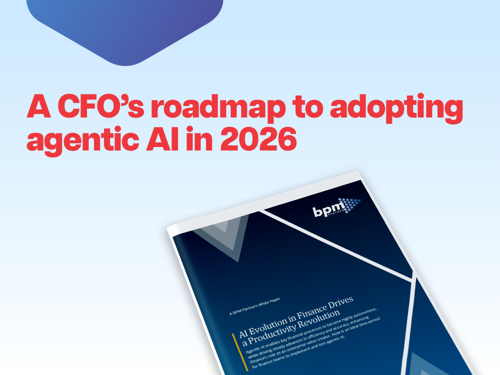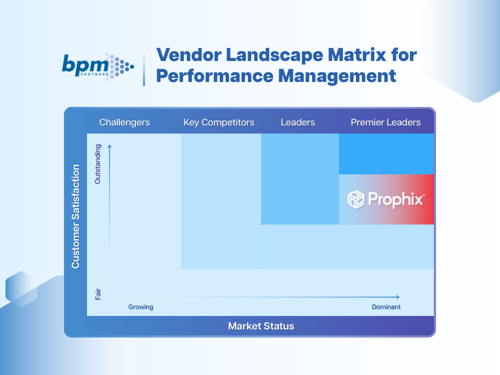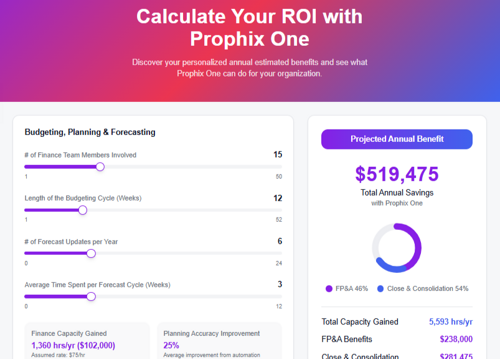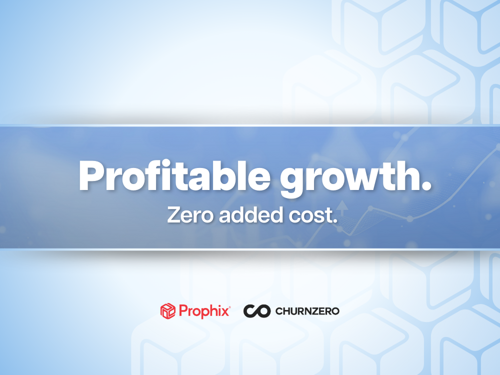Download the BPM Partners Whitepaper
How President Trump’s tariffs will affect finance teams
Learn how Trump's tariffs could shape the economy in 2025 and impact businesses and finance teams alike.
February 14, 2025President Trump’s tariffs pose significant challenges for finance teams, from rising costs to disrupted supply chains and financial strain. What steps can organizations take to tackle these obstacles and thrive in 2025?
Today, we dive into these challenges with Aaron Levine, CFO at Prophix, who shares practical strategies finance leaders can use to prepare for tariff impacts.
What are Trump’s tariffs?
In late January, President Trump announced his plan to implement a 25% tariff on Canadian and Mexican imports, as well as a 10% tariff on Chinese imports. Energy resources from Canada will also have a 10% tariff.
After a discussion in early February between President Trump and Canada’s Prime Minister Justin Trudeau, Trudeau agreed to send 10,000 frontline personnel to the border and appoint a “fentanyl czar” to meet Trump’s demands, and as a result, the tariffs were delayed for 30 days (CTV). Similarly, a meeting between President Trump and Mexican President Sheinbaum resulted in the Mexican tariffs being paused for 30 days (CBC).
However, on February 11, Trump announced his plan to implement a 25% tariff on steel and aluminum imports beginning on March 12, with no possibility for concessions (BBC).
As such, the situation with Trump’s tariffs is evolving, with the possibility of the original tariffs being implemented after the 30 days expire.
How will Trump’s tariffs affect finance teams?
For finance teams, Trump’s tariffs have the potential to disrupt supply chains, increase the cost of manufacturing and purchasing certain goods, eliminate hundreds of thousands of jobs, and limit collaboration between companies operating across borders (KPMG). For example, car manufacturing is expected to be hit particularly hard, as vehicle parts cross the Canadian and Mexican borders several times before the vehicle is completely assembled (BBC).
And as a trade war looms, Canada, Mexico, and China have begun discussing their own retaliatory tariffs, which could further complicate the situation.
For many businesses in Canada and Mexico, Trump’s tariffs mean putting investments on hold as they can’t predict “what sort of environment a future capital investment or expansion is going to face” (BBC). Many economic experts are predicting a “mild recession” in the next two years as a result of Trump’s tariffs (Financial Post).
Q&A with Aaron Levine, CFO at Prophix, on Trump’s tariffs and their impact on finance teams
To better understand how Trump’s tariffs will affect the economy and finance teams, we sat down with Aaron Levine, CFO at Prophix, to discuss how CFOs can prepare their businesses.
As a CFO, what are your initial thoughts on the impact that Trump’s tariffs will have on finance teams?
Aaron Levine (AL): “Trump’s tariffs will introduce complexities that ripple through finance teams. They affect everything from cost structures and cash flow to pricing strategies and forecasting. Tariffs generally impact tangible goods, so the immediate concern is around increased costs for raw materials. This will create margin pressure for businesses, making pricing and cost structures a top priority for finance leaders.
For finance leaders, this requires sharper financial planning. They need robust scenario modeling, and an even closer monitoring of expenses and margins. Being able to pivot quickly will be key, for example, automating financial modeling to assess various tariff impact scenarios and track the financial effects of tariffs in real-time, so that you can adjust forecasts accordingly.”
What are you, as a CFO, doing to prepare for the possibility of Trump’s tariffs?
AL: “Trump’s tariffs could have a variety of impacts, and you have to understand what it will mean for your team and your business in different situations. So, preparation starts with scenarios—understanding the full scope of exposure and where there may be impact.
You need to consider what happens if tariffs go into effect and then become eliminated or obsolete. Modeling multiple “what-if” scenarios and their financial outcome is really important to simulate the impact across all dimensions of your business. It’s all about being ready for uncertainty.”
What steps can finance teams take to protect profit margins while remaining competitive in the market?
AL: “Profit margins are even more important today with Trump’s tariffs. Businesses should always be looking for efficiencies and ways to decrease costs. And in particular, with Trump’s tariffs, I think finance teams should explore alternative suppliers in non-tariff regions. Having strong supplier relationships will be important for businesses with tangible goods to negotiate cost-plus-pricing models.
It’s an exercise in balancing cost controls with market competitiveness. Strategies could include:
- Exploring alternative suppliers in non-tariff regions.
- Negotiating better terms with existing vendors.
- Implementing cost-plus pricing models where possible.
- Identifying operational efficiencies to offset tariff-related cost increases.
And as I said, looking for operational efficiencies is important, but with that comes the need to leverage technology to reduce manual processes, improve overall efficiency, and budget and plan more accurately.
So, looking at leading vendors such as Prophix to help you model and find efficiencies in the finance function is important.”

How closely should finance teams work with other cross-functional departments to assess and mitigate the financial impact of Trump’s tariffs?
AL: “Navigating tariff impacts is not something finance teams can do in isolation. Working with groups from across the organization, from operations and sales to supply chain and legal is critical. And FP&A teams play a crucial role in integrating all these business functions by running financial impact analyses, scenario modeling, and pricing strategies. Real-time data sharing and collaboration with procurement, legal, and commercial teams will ensure a proactive rather than reactive response to tariff changes. Tools that support integrated planning, such as Prophix One FP&A Plus, can enable seamless collaboration across departments, ensuring all teams have access to the latest financial insights and are aligned in their strategic response.”
How can finance teams prepare and adapt to the potential long-term shifts in the economic and trade environment?
AL: “The economic and trade environment will continue to challenge us in ways we can’t always predict. What we can control is how prepared we are, and long-term success will hinge on agility and strategic foresight. Finance teams should:
- Invest in predictive analytics and scenario planning to stay ahead of trade policy shifts.
- Build more resilient supply chains with diversified sourcing strategies.
- Strengthen relationships with suppliers and logistics providers to ensure flexibility.
- Continuously reassess cost structures and pricing strategies to maintain competitiveness.
- Advocate for digital finance transformation to improve efficiency, agility in decision-making, and cross-functional collaboration.”
Read more about Aaron’s 2025 predictions for mergers and acquisitions.
What potential impact will Trump’s tariffs have on cash flow and what strategies can finance teams put in place to manage this impact?
AL: “Trump’s tariffs, and their impact on cash flow, are top of mind for a lot of CFOs. Tariffs can place an outsized burden on cash flow, as duties increase costs or delay payments. And with the potential for delayed payments on the customer-side, it’s all the more important to have a good handle on your cash flow.
The key is to monitor liquidity with laser focus. To manage cash flow impact, finance teams should:
- Extend payment terms where possible.
- Optimize inventory management to avoid overstocking or shortages.
- Leverage short-term financing options strategically.
- Regularly update rolling cash flow forecasts to account for tariff-driven cost fluctuations.
And the best way to implement these strategies is to use cash flow planning software like Prophix One to get a good handle on your cash flow model.”
How can finance teams mitigate the risk posed by the potential shifts in exchange rates?
AL: “Tariff uncertainty can lead to foreign exchange fluctuations, particularly in trade-heavy industries. Foreign exchange (FX) rates are big part of pricing strategies, and finance teams can mitigate FX risk in several ways by:
- Utilizing hedging strategies such as forward contracts or options and leveraging a network of financial partners to maximize effectiveness.
- Taking advantage of a natural hedge by aligning cash inflows and outflows in the same currency, which can reduce foreign exchange risk.
- Pricing products in a way that incorporates currency risk.
- Diversifying supplier locations to reduce reliance on any single currency.
- Keeping a close eye on geopolitical developments that may affect exchange rates.”
What impact could Trump’s tariffs have on company’s investment strategies or expansion plans?
AL: “I think tariffs will have an impact on mergers and acquisitions, and certainly on ‘bolt-on’ acquisitions. One thing that tariffs really affect is profitability, and profitability is a big driver for earnings multiples, which impacts valuations.
Tariffs will introduce some uncertainty in the M&A market, and companies may react in different ways. I think there may be some consolidation in the market overall, as companies look to strengthen their market position. And some larger, stronger companies may come to market looking for a premium valuation.
So, keeping a steady pulse on key valuation drivers is really important, including your EBITDA, your gross profit margins, and your working capital. And CFOs are going have to look ahead and communicate the long-term strategy for dealing with the tariffs and their impact on the company’s growth and profitability going forward.”
Conclusion: Preparing for tariff challenges with Prophix
Trump’s tariffs highlight the critical need for finance teams to stay agile and prepared. From disrupted supply chains to rising costs, the challenges are clear—but so are the opportunities to adapt and thrive with the right technology.
Prophix One, a Financial Performance Platform, empowers finance teams with robust scenario planning, enabling you to swiftly model the impact of variables like increased COGS or decisions to absorb or pass along costs. With Prophix One FP&A Plus, you can tackle complex variables with speed and precision—whether managing thousands of SKUs or addressing the financial impact of shifting supplier costs and sourcing strategies.
AI-driven predictive forecasting ensures you’re always a step ahead, providing clarity in uncertain times. Whether it’s running “what-if” scenarios, forecasting cash flow impacts, or adapting pricing strategies, Prophix will help your team stay resilient in the face of economic uncertainty.
Plan for tariff impacts by scenario planning with Prophix One.





